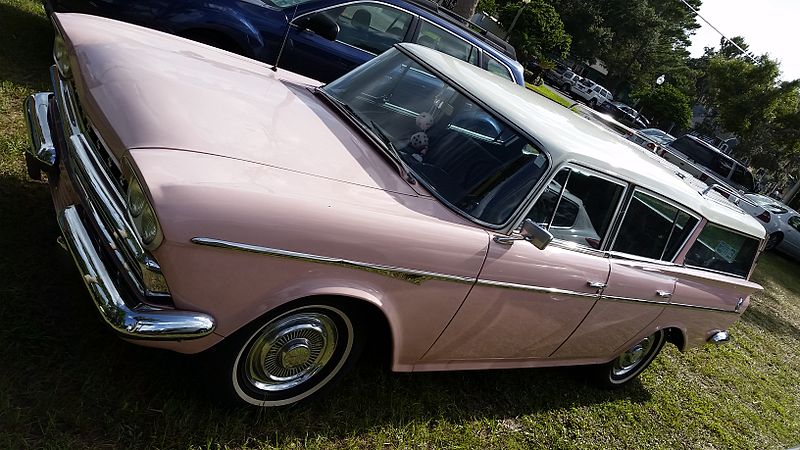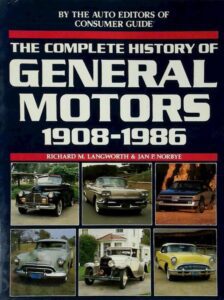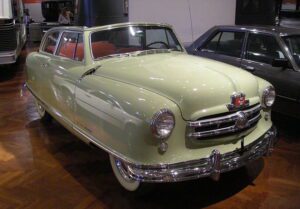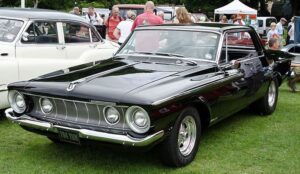
Indie Auto: Did Detroit Give Us the Dinosaurs?
 Indie Auto: Excusing Detroit?
Indie Auto: Excusing Detroit?
Steve Salmi’s Indie Auto is an interesting opinion website for car nuts, focusing on auto history, mostly American. It’s worth a visit for freewheeling thoughts and second-guessing triumphs and tragedies. Recently Steve reviewed a book I’d forgotten, The Complete History of General Motors 1908-1986 (with Jan P. Norbye; Skokie, Illinois: Publications International, 1987.) “Langworth and Norbye,” says the review, “made excuses for General Motors’ big-car fixation”:
The authors were presumably responding to Brock Yates’ (1983, 2018) contention that Detroit failed adequately to respond to a rising tide of foreign small cars because its top executives were “Grosse Pointe myopians” who lived such insular lives that they did not comprehend the cultural shifts taking place in the likes of California.
It’s nice to be remembered, even critically, for something we wrote nearly 40 years ago. (As I recall, we refused to write beyond 1975 or so, given the sorry state management had reduced GM to by then; the editors brought it up to date.) But I was left perplexed by the accusation of “diatribes” and “making excuses” for Detroit’s postwar fetish with big cars. I assured Indie Auto that my late friend Jan and I were not responding to something Brock Yates said. (If Brock actually wrote that car sizes were dictated by “Grosse Pointe myopians,” he was just stirring the pot—something at which he was a master.)
Age of the Dinosaurs
I remember a 1973 remark of our brilliant Automobile Quarterly editor Don Vorderman, to the great Italian designer Giorgetto Giugiaro. “Americans,” said Don, “generally buy the biggest car they can afford. Europeans buy the best car they can afford.” Giugiaro, Don recalled, “just sadly shook his head. Perhaps we should, too.”

Of course, that was a long time ago, and we know more about cars now. But it’s always good to look back and benefit from past foolishness.
Indie Auto stated: “U.S. automakers ignored the growth of imports until they introduced decontented compacts in 1970.” While Detroit’s Big Three did ignore imports when they were a small slice of the market, they brought out smaller cars in 1960, after Rambler sales soared and the Lark temporarily saved Studebaker. Caught napping, they rushed out the Corvair, Falcon and Valiant, the first so-called “compacts.” Almost immediately, market forces dictated the arrival of larger “intermediates.” Thus the Chevy Corvair was soon accompanied by the Chevy II, and then the yet larger Chevelle, which handily outsold both.
“The compact Rambler sold well enough that it singlehandedly saved Nash,” states Indie Auto, “while the sales of its big cars slowed to a trickle.” Norbye and I “failed to acknowledge that American Motors Corporation sales fell off when the company began pushing big cars again.”
Both statements are true. The Rambler surge was almost wholly due to public demand for more economical cars during the late Fifties and early Sixties. Demand increased during the 1958 Recession, the death knell for medium-priced big cars like the newly-introduced Edsel. Long-established makes like DeSoto, Nash and Hudson disappeared.
George Romney: right place at the right time
George Romney, president of American Motors in 1954-62, had a car buyers wanted, and Rambler sales took off. When his successor, Roy Abernethy, opted to turn AMC from a niche manufacturer into a full-line company, he ran into the Big Three’s dominant products, and AMC’s market share collapsed.
Of course Romney also brought in enlightened management that helped build a more efficient company. But I always thought he happened to be where he was at the right time. The first Nash Ramblers (1950) were little more successful than other “econo-cars” of the era: the Henry J, Aero-Willys or Hudson Jet. It took a shift in public taste to interest buyers alternatives to what Romney called “gas-guzzling dinosaurs.” The Rambler became a game-saver virtually by accident, when a small but growing segment of the U.S. buyer market began thinking economy. It was there to salvage AMC, which would otherwise have been stuck with middle-priced losers during the 1958 recession.
Rebuttals and “plucked chickens”
Steve and Indie Auto gamely replied, asking two questions: (1) Where is the evidence that the public wanted ever larger Chevrolets, say between 1954 and 1969? Answer: The same place as evidence that they wanted larger Cadillacs. (The Vorderman-Giugiaro dialogue.) For most of the 1960s, those big Chevys, powered by ever more potent V-8s, sold like hotcakes.

(2) If the 1962-63 downsized Dodge and Plymouth were such disasters, how come they outsold their full-size counterparts? Because the full-size models were more costly and naturally produced in lower volume.
Designer Virgil Exner called those smaller cars the “plucked chickens.” They were the result of a basic miscalculation: Management had thought GM intended to bring out downsized Chevys in 1962. Realizing too late that this wasn’t the case, they rushed out the full-size Dodge Custom 880 to give Dodge dealers a big car to sell. (Plymouth dealers already had one, since they were dualled with Chrysler, whose Newport sold for only $250 more than the previous year’s Fury. The Custom 880 was simply a Dodge-badged Newport.)
Of course the “dinosaurs” carried a higher price and did not outsell the “plucked chickens.” The 880 was also a stopgap to capture the market vacated by dropping DeSoto. (Ironically, before its demise, there were clay models of the proposed 1962 DeSoto with styling similar to Ex’s “plucked chicken” Plymouths and Dodges. Fortunately, that mistake was avoided.)
Indie Auto was, however, right to emphasize the factor of imports, although Detroit paid little attention to them until their market share rose above 10%. Volkswagen was a unique threat because unlike its rivals, the company insisted on exclusive dealerships with adequate parts stocks and mechanic training. In addition, VWs offered high quality and the ability to be driven flat-out all day. This gave the Bug a leg up that Renault, Fiat and Austin didn’t have. VWs were selling well before the ’58 recession.
Who demanded land-yachts?
Jan Norbye’s and my point was that the public determined what Detroit built, not the other way round. When Detroit guessed wrong we got the Hudson Jet and the Edsel. When they guessed right—the 1965 Ford Mustang, for example—they were in fat city.
Indie Auto said we were “disingenuous” to state that the public kept demanding larger cars than the original compacts. Yet their own graph shows Dodge-Plymouth sales bottoming after introducing the “plucked chickens.” And they admit that the 1961-63 Buick-Olds-Pontiac Y-Body compacts “did not sell nearly as well as their mid-sized successors introduced in 1964.”
Their take, Indie Auto says, is “more subtle.” As the American economy improved in the early 1960s, “a growing proportion of car buyers gravitated to larger and fancier cars.” Which is nothing more than we not-so-subtly wrote in our book. No argument!
In the heyday of Detroit, companies spent millions trying to understand what buyers wanted—and acted accordingly. It wasn’t a case of “Grosse Pointe myopians” dictating their preferences. Almost every notable failure—from the Henry J to the Edsel to the longer-wider-faster American Motors mid-60s models—was an example of product planners misreading market forces. And every notable success, from the early Rambler to the ponycar to the SUV, was an example of getting it right—or stumbling into reality.
For whatever they built (and they built some pretty bad cars), as we said in our book: Don’t blame Detroit. Blame us.







2 thoughts on “Indie Auto: Did Detroit Give Us the Dinosaurs?”
Richard:
I came out to Rootes Canada from Coventry in 1962, a product of a Rootes Group management training program. So I was small-car loyal, firmly believing that the Hillman Minx was all that the average Canadian really needed. Inevitably I quickly came to recognize shortcomings of British (and French and Italian) cars when it came to coping with North American climate and road conditions but, that aside, the thing that disheartened me most was that the mechanics at Rootes-Canada’s retail dealership in Toronto, most of them immigrants from Britain, mainly drove domestic cars—the bigger the better. Such cars were what they wanted—indeed lusted after. Those cars exemplified for them a new standard of living achieved—proof they had “arrived.” Detroit was giving them, and their Canadian friends and neighbours, exactly what they wanted. Incidentally, in my library I do not have the Langworth and Norbye book re General Motors discussed by you here, but I do have your Complete History of Chrysler and Great Cars of the 20th Century, both valued reference works. And, of course, frequently visited because of my love of the Renown, Triumph Cars.
–
Peter: In my youth I was a devoted Rootes fan, owned four Sunbeams and a Humber Imperial. Always thought they offered an attractive combination of sportiness and creature comforts. But you’re right about lack of understanding among British producers of the North American market. Kjell Qvale, that phenomenally successful British car dealer in California, used to talk about the MG 1100—thought at one time a rival to VW. Executives back in England could not understand why 1100s were wearing out engines in LA and clutches in SF—two cities so close on the map! They’d never been to California… —RML
Where do I start? Indie Auto: though there’s food for thought it is littered with latter-day wishful thinking and hardheaded biased diatribes, in my humble opinion. Not that I don’t have my own. I do agree that there was, and is, what I call Michigan Myopia. During the 1960s-70s I devoured Brock Yates’s column and Car & Driver, probably where my thoughts were originally formulated. I can’t say I’ve been dissuaded. Where I disagreed was the broadly thought “European cultural superiority” mindset. Europe sold two cars: expensive, finely engineered cars for the wealthy, and econoboxes for the common man. I’ve always maintained that the Rolls-Royce Shadow was really nothing more than a complicated hand-built Chevrolet Caprice. An American plumber could afford the Chevy. Why wouldn’t he buy one?
Back in the early seventies, as a young man in SoCal, I thought that Detroit had lost its way and was laughably behind the times. For example, Pontiac brought out The Judge, and I winced at the clueless attempt to be “hip.” It was an embarrassment. Until recently, the Midwest was full of Detroit iron, whereas nobody I knew bought any Big Three products except trucks. We bought Japanese. Not as “stylish” but solidly built.
Other notes: The Ford Falcon was a runaway success, and the Chevy II was rushed in as a virtual Falcon clone. The Corvair was an abject failure, saleswise in its originally intended economy car market. Falcon outsold the Corvair 3 to 1 in 1960.
The hoary old theory, “American Motors failed trying to compete with the Big Three” overlooks the main reason for its decline. When the 1964 “Rambler-sized” GM intermediates, specifically the Chevelle, were introduced, the market Rambler dominated was flooded with product. The failed ’62 downsized Plymouth and Dodge were a ready-made intermediate, and soldiered on in this market, after the bizarre styling had been muted. Rambler/AMC had nowhere else to go… but mustered on for another 20 years. Thanks for suffering my own diatribe.
–
Scott, thanks for the interesting thoughts. Brock Yates was a great writer, but he did ride the reverse-snobbery wagon. Don Vorderman’s quip that Americans bought the biggest, Europeans bought the best, did not suggest “European cultural superiority,” just car buying habits. Indeed lots of US product planning was clueless, but against the silly Pontiac “Judge” you have to lay the GTO, which virtually invented the musclecar, one of those phenoms where Detroit lurched into a real public desire—and the public responded. About AMC, we’re really saying the same thing. True, the Big Three reacted to Rambler with Rambler-clones. I’m not sure ANY approach would have ultimately saved AMC. Whether it was Roy Abernethy’s full-line company or Romney’s niche company, the trail was narrowing because AMC did not have the same economies of scale. Jan Norbye once said GM was so big, and made so much money selling stuff to itself, that if you started managing it badly you wouldn’t see the results for ten years. That was in 1973, around the time they started managing it badly—and ten years later, sure enough!) —RML
Comments are closed.